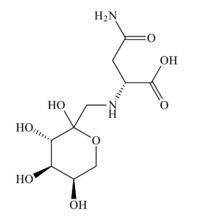Formula C10H18N2O8 | Appearance off white crystals | |
 | ||
Fructose-asparagine is a glycosylamine compound that is used during Salmonella-mediated inflammation of the intestine. The name of the genetic locus that encodes the uptake capability in Salmonella is fra. This fra locus has five genes: fraR (a regulator), fraB a fructose-asparagine deglycase, fraD a sugar kinase, fraA a fructose-asparagine transporter, and fraE a L-asparaginase.
Contents
Properties
Fructose-asparagine is a aminodeoxysugar. It takes the form of a pale yellow solid. It decomposes above 120 °C.
Production
Fructose-asparagine is formed when cooking food by way of the Maillard reaction. Fructose-asparagine can be prepared by refluxing D-glucose with sodium bisulfite in methanol, and then adding L-asparagine, and then acetic acid or malonic acid. An ion exchange resin then can separate the product from other contaminants.
Fructose-asparagine is found naturally in some foods, with dried asparagus containing 1.4% and carrot containing 0.1%.
